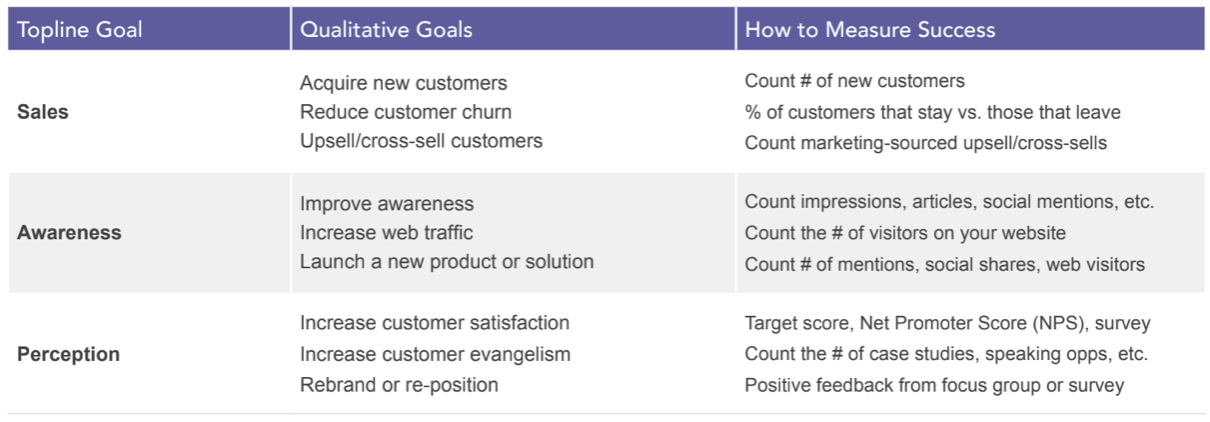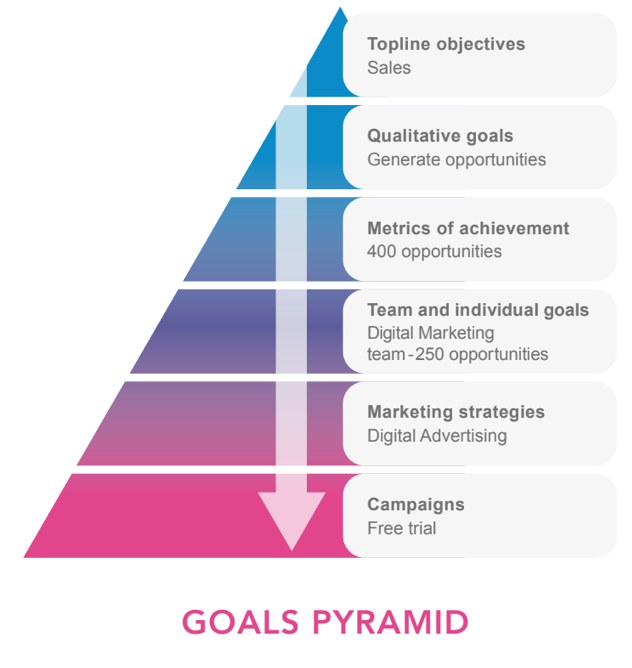A Marketing Plan is Based on a Set of Measurable Goals that Align with Company Objectives

If you set goals you can define what success looks like; maximize your chances of successful outcomes; baseline your performance; align the team’s activities around the most important tasks; avoid random acts of marketing; make wiser investment decisions (again, plan and budget are inextricably linked). If you align your marketing goals with corporate goals, then you are able to more easily demonstrate the business value that your marketing plan has delivered, in terms that make sense to the business.
Improving Your Marketing Plan
Defining goals can be very easy or complicated depending on the stage of your company. Companies that are smaller may have more to accomplish, but they have fewer resources to achieve and track these goals. For larger established companies, the goals may be clearer, but with a large team comes a variety of individual goals that must support marketing initiatives and company objectives.
In any case, the first step in the process is to get executive team alignment on the company objectives. Marketing will have a significant role in achieving company objectives, so it’s critical that plans and budgets are created with goals in mind. In order to ensure this is carried out, you must get the whole marketing team’s buy-in regarding the top-notch goals. Without executive alignment and the marketing team’s complete buy-in on the goals, confusion on strategy and tactics will follow.
Top-line Marketing Objectives
When establishing what you need to achieve for the upcoming year, remember not all goals can be accurately measured. For this reason, marketers should feel comfortable using a mixture of both quantitative (“x number of leads) and qualitative (”rebrand the company”) goals. For both large or small companies, all goals can be consolidated into three top-line marketing objectives:
• Sales (maintaining or expanding the business)
• Awareness (getting the word out)
• Perception (managing brand, positioning, messaging)
Below is a chart with examples of commonly used goals that fit under top-level objectives:

The Goals Pyramid
A Goals Pyramid pulls all your strategic marketing together to provide clear direction to the team. The Pyramid starts with your top-line marketing objectives which are matched up with more specific qualitative goals, metrics, and strategies to achieve the objective. A Goals Pyramid contains:
- Top-line objectives: Almost all marketing goals fall into one of three top-line objectives: sales, awareness, or perception. This is why they are at the top of the goals chain. They help structure the rest of your thinking as you start the marketing planning process.• Qualitative goals: These are more descriptive and customized to your unique business needs. In our example below, a qualitative goal of “generate opportunities” provides more color to the topline goal of “sales.”• Metrics of achievement: These are the quantifiable goals that provide specific measurement to the qualitative goals. In our example Pyramid, we have written: “generate 400 opportunities.”• Team/individual sub-goals: These are metrics-based sub-goals the team or an individual needs to achieve. In our example, the digital marketing team needs to create 250 of the 400 opportunities next year.• Marketing Strategy: This is the strategy you’re using to achieve the goal. In the example below, the digital marketing team is using a “digital advertising strategy” to reach the target audience and generate 250 opportunities.
• Marketing Campaigns: All your campaigns should be goal-based, no matter how big or small. The campaigns will leverage the strategy and will aim to achieve the goal metrics. In our example, the campaign will promote a free trial in order to reach the goal of 250 opportunities.
If you use the Goals Pyramid method, your team will always stay focused on what really matters so you can avoid empty-calorie marketing.

If you are interested in learning more about creating a winning marketing plan you can download our eBook here.

Dan Faulkner is co-author of The Next CMO: a guide to operational marketing excellence, and the CTO of Planful, where he is responsible for the technical strategy and delivery of the world’s first AI-powered marketing performance management software. Dan has 25 years of high-tech experience, spanning research and development, product management, strategy, and general management. He has deep international experience, having led businesses in Europe, Asia, North America, and South America, delivering complex AI solutions at scale to numerous industries. Dan holds a Bachelor’s degree in Linguistics, and Masters degrees in Speech & Language Processing, and Marketing. He has completed studies in Strategy Implementation at Wharton.
Latest Posts
Blogs
Interviews, tips, guides, industry best practices, and news.
